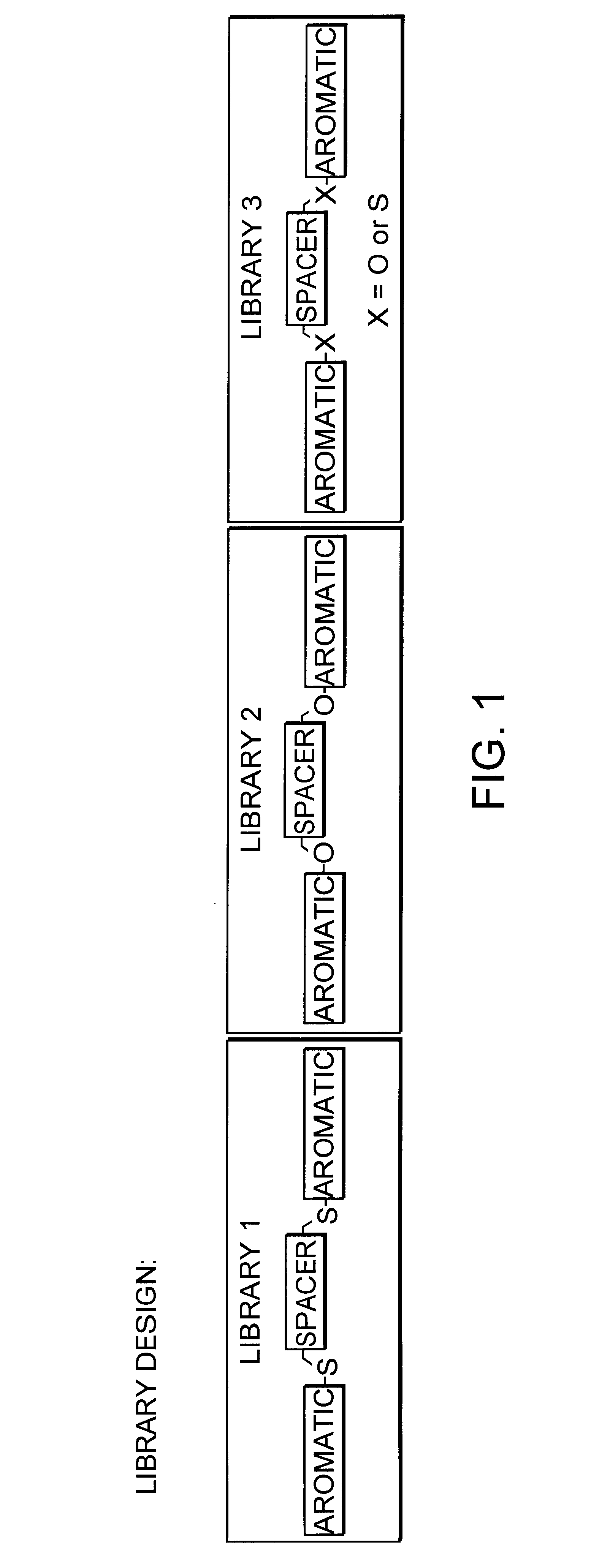Anti-picornaviral ligands via a combinatorial computational and synthetic approach
a combinatorial computational and synthetic approach technology, applied in the field of antipicornaviral ligands via combinatorial computational and synthetic approach, can solve the problems of unstable vaccine development, limited effectiveness of existing drugs which are used against the viruses described above, and unstable vaccine developmen
- Summary
- Abstract
- Description
- Claims
- Application Information
AI Technical Summary
Benefits of technology
Problems solved by technology
Method used
Image
Examples
example 2
This Example Demonstrates the Synthesis of Library 2 as Shown in FIG. 1
A mixture of five desired monomers (FIG. 2c) at 0.6 mmol each and five desired dibromide spacers (FIG. 2b) at 0.3 mmol each were dissolved in 4 ml DMF under N.sub.2. Solid K.sub.2 CO.sub.3 of 0.415 g (3 mmol) was added to the solution which was subsequently stirred at 57.degree. C. overnight. The reaction mixture was then diluted with water and extracted with Et.sub.2 O and EtOAc. Subsequently, the organic phase of the reaction mixture was washed with 2M NaOH, dried over K.sub.2 CO.sub.3, and concentrated. The resulting amber colored material was then dried at high vacuum. Assuming that all of the reactions occurred as planned, the library is expected to consist of 75 [Formula 1 above, where m is the number of spacer monomers (here 5)] and n is the number of hydroxyl monomers (here 5))compounds including all possible unique combinations of the allowed monomers.
example 3
This Example Demonstrates the Synthesis of Library 3 as Shown in FIG. 1
A mixture of five desired thiol monomers (FIG. 2a) at 0.6 mmol each, five desired phenol monomers (FIG. 2c) at 0.6 mmol each as well as the five desired dibromide spacers (FIG. 2b) at 0.3 mmol each were dissolved in 4 ml DMSO under N2. Solid K.sub.2 CO.sub.3 of 0.829 g (6 mmol) was added to the solution which was then stirred at 57.degree. C. overnight. The reaction mixture was subsequently diluted with water, extracted with Et.sub.2 O and EtOAc. The organic phase of the reaction mixture was washed with 2M NaOH, dried over K.sub.2 CO.sub.3 and concentrated. The resulting amber colored material was then dried at high vacuum. Assuming that all of the reactions occurred as planned, the library is expected to consist of 275 [Formula 1 (above), where m is the number of spacer monomers (here 5) and n is the number of thiol monomers plus the number of hydroxyl monomers (here 5+5=10)] compounds including all possible com...
example 4
This Example Demonstrates the Synthesis of Library as Array in Microtiter Plates
The procedure to synthesize library as array in a 8.times.12 microtiter plate is as follows: 1) to each well of the plate, adding a stoichiometric amount of K.sub.2 CO.sub.3, it may be necessary to make an aqueous solution to make the dispensing easier, 2) to each well of a horizontal row, adding a stoichiometric amount of a single pre-determined monomer, changing the identity of the monomer for each horizontal row, 3) to each well of a vertical column, adding a stoichiometric amount of a single pre-determined monomer, changing the identity of the monomer for each vertical column, 4) to each of the 96 wells, add a stoichiometric amount of a single pre-determined spacer dibromide in DMF (different dibromides would be used on separate 96 well plates).
PUM
| Property | Measurement | Unit |
|---|---|---|
| temperatures | aaaaa | aaaaa |
| period of time | aaaaa | aaaaa |
| volumes | aaaaa | aaaaa |
Abstract
Description
Claims
Application Information
 Login to View More
Login to View More - R&D
- Intellectual Property
- Life Sciences
- Materials
- Tech Scout
- Unparalleled Data Quality
- Higher Quality Content
- 60% Fewer Hallucinations
Browse by: Latest US Patents, China's latest patents, Technical Efficacy Thesaurus, Application Domain, Technology Topic, Popular Technical Reports.
© 2025 PatSnap. All rights reserved.Legal|Privacy policy|Modern Slavery Act Transparency Statement|Sitemap|About US| Contact US: help@patsnap.com



